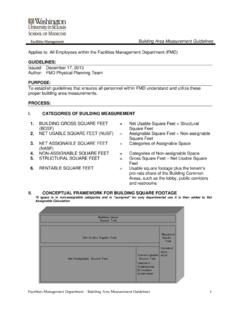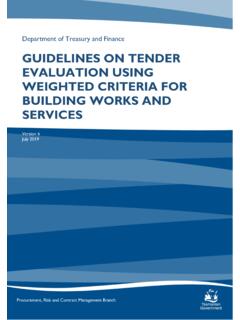Transcription of BUILDING, FLOOR, AND ROOM NUMBERING GUIDELINES …
1 Capital Planning and Space Management building , floor , and room NUMBERING GUIDELINES building , floor , AND room NUMBERING GUIDELINES general These NUMBERING conventions have been developed and should be followed throughout Institute controlled facilities for the purpose of standardizing room numbers. For new buildings, these standards should be followed as closely as possible. In cases of renovations or additions to existing buildings, the building s existing NUMBERING system can be extended, or abandoned in order to use the following standards to renumber the entire building including the renovated and/or added space. The intention is for each facility s floor and room NUMBERING scheme to be structured so that the numbers flow through the building in a consistent, comprehensible, and user-friendly pattern.
2 The scheme should be clear to the users of the facility, not causing confusion for individuals attempting to locate spaces. building NUMBERING The Office of Capital Planning and Space Management is responsible for assigning all building numbers. These numbers are always three digits (leading zeroes included) followed by an optional alphabetic suffix. Generally, the following NUMBERING ranges are used: 000 200: Institute-owned or controlled buildings 300 399: Non-Institute controlled buildings; also areas or structures which are not buildings but which appear on the campus map 800 899: Leased buildings building numbers with an alpha suffix are usually associated with the non-suffixed building number. These are frequently additions to the original building , or other smaller buildings that service the main building .
3 In the case of leased facilities, these may also simply indicate buildings near each other or in the same general location. Each separate structure is usually given its own unique building number. However, in the case of multi- building complexes (such as student residence halls), a single number has sometimes been used. room numbers in each separate building then have a distinct alphabetic prefix such as E for east building , W for west, etc. These are considered to be special cases, and the Office of Capital Planning and Space Management will determine when this method will be utilized. floor NUMBERING The first character of a room number indicates the floor level of the building . The level with a 1 as the first character should be the uppermost floor entered at grade or one half flight above 10/4/02 1 of 6 Capital Planning and Space Management building , floor , and room NUMBERING GUIDELINES grade.
4 Levels below this can use the character 0 (zero), B (basement), or G (ground), depending upon the arrangement and number of these floors. Buildings located on steeply sloping sites may need to vary from this rule; where necessary, the floor numbered 1 may not in fact be the uppermost floor entered at grade. Where B and 0 (zero) are used in the same building , the B level will be below the 0 level. The only cases where the floor indicator should more than one character are buildings with more than nine floors. Large mezzanines shall be numbered as a whole floor . Example: When a mezzanine exists between the first floor and the next whole floor , it will be numbered as the second floor . Usable attic floors and penthouse levels should be numbered as if they are whole floors.
5 For example, a two-story penthouse atop a three floor building will be numbered as the fourth and fifth floors. Do not use prefixes such as R for roof level. room NUMBERING The GUIDELINES in this section should be followed as closely as possible when assigning numbers to individual rooms. Use 3 or 4 digit numbers (plus optional alpha suffix) consistently throughout the building Rooms shall be numbered with a three or four digit number, where the first digit may be optionally replaced with the letter B or G (see floor NUMBERING above); the length depends upon the size of the building and once chosen shall be consistent throughout the entire building . With an optional letter suffix, the maximum length of a room number is 5 characters.
6 Three digit numbers shall be used for buildings with 9 or fewer floors and 99* or fewer rooms per floor . The first floor will be numbered 100 s; second floor will be 200 s; third floor will be 300 s etc. Ground floor or basement rooms could be numbered 001, 002, etc. or G01, G02, etc. or B01, B02, etc. Note: the following examples use spaces in the room number to clarify and illustrate the NUMBERING scheme; these spaces should not appear in the actual room number. Example: building with 9 or fewer floors and 99* or fewer rooms per floor G 41 indicates room number indicates floor (ground floor ) 3 02 indicates room number indicates floor (third floor ) Four digit numbers shall be used for buildings exceeding 9 floors or having more than 99* rooms per floor .
7 Buildings with wings or sections can also use four digit numbers if this makes the NUMBERING scheme easier to navigate. 10/4/02 2 of 6 Capital Planning and Space Management building , floor , and room NUMBERING GUIDELINES Example: building with more than 9 floors and 99* or fewer rooms per floor B0 02 indicates room number indicates floor (basement floor ) 01 02 indicates room number indicates floor (first floor ) 11 02 indicates room number indicates floor (eleventh floor ) Example: building with 9 floors or less but more than 99* rooms per floor B 102 indicates room number indicates floor (basement floor ) 1 102 indicates room number indicates floor (first floor ) Example: building divided into wings or sections G 1 02 indicates room number indicates wing or section (numeric only) indicates floor (ground floor ) 1 1 02 indicates room number indicates wing or section (numeric only) indicates floor (first floor ) 10/4/02 3 of 6 Capital Planning and Space Management building , floor , and room NUMBERING GUIDELINES * The actual number of rooms requiring the use of four-digit room NUMBERING will vary, depending upon how many numbers are skipped and also the number of suites vs.
8 Rooms requiring non-suffixed numbers. Numbers should flow from one end of the building to the other In a building with only one dividing corridor, room numbers should flow in ascending order from one end of the building to the other. In a building with a more complex corridor system, numbers should flow in ascending order in a clockwise direction through the corridors from the main entrance, or similar location such as elevator lobby. Use odd numbers on one side of a corridor and even numbers on the other side room numbers shall be coordinated so that even numbers are on one side of a corridor and odd numbers are on the other side. (In more complex designs, or where the availability of numbers is limited, the odd-even format can be abandoned if consecutive NUMBERING results in a more logical scheme.)
9 Skip numbers to maintain succession of room NUMBERING In some instances, room numbers on one side of a corridor shall be skipped in order to maintain succession with the room numbers on the opposite side of the corridor. This may occur, for example, when a suite of rooms or large space is accessed through a single door and there are no other doors on that same side until further down the corridor. This will allow for future renovations that may convert suites or large spaces into separate or small rooms with a corridor door. Skip numbers to allow for future renovations When a corridor contains large rooms such as classrooms, meeting rooms, etc. on both sides of the corridor, room numbers shall be skipped to allow for future renovation of a large space into smaller spaces.
10 Sufficient numbers shall be reserved to allow for the large spaces to be divided into standard size office spaces. Use similar NUMBERING on each floor NUMBERING systems on all floors should be similar as much as possible, even when the floor plans are significantly different. To the greatest extent possible, and without creating other inconsistencies, rooms with the same digits in the last positions should be located in the same position in the building . Thus, B01, G01, 001, 101, 201, etc., occur in a vertical stack. Use alphabetic suffixes for rooms entered from other rooms (rather than a hallway) Rooms entered from a main corridor or lobby are numbered with no letter suffix. When rooms open off of another room and not from a corridor (such as in a suite of offices), use the number of the first room with a letter suffix (example: Reception 301, Office 301A, Office 301B, Office Storage 301C).






